2017 NISSAN TITAN manual transmission
[x] Cancel search: manual transmissionPage 591 of 671
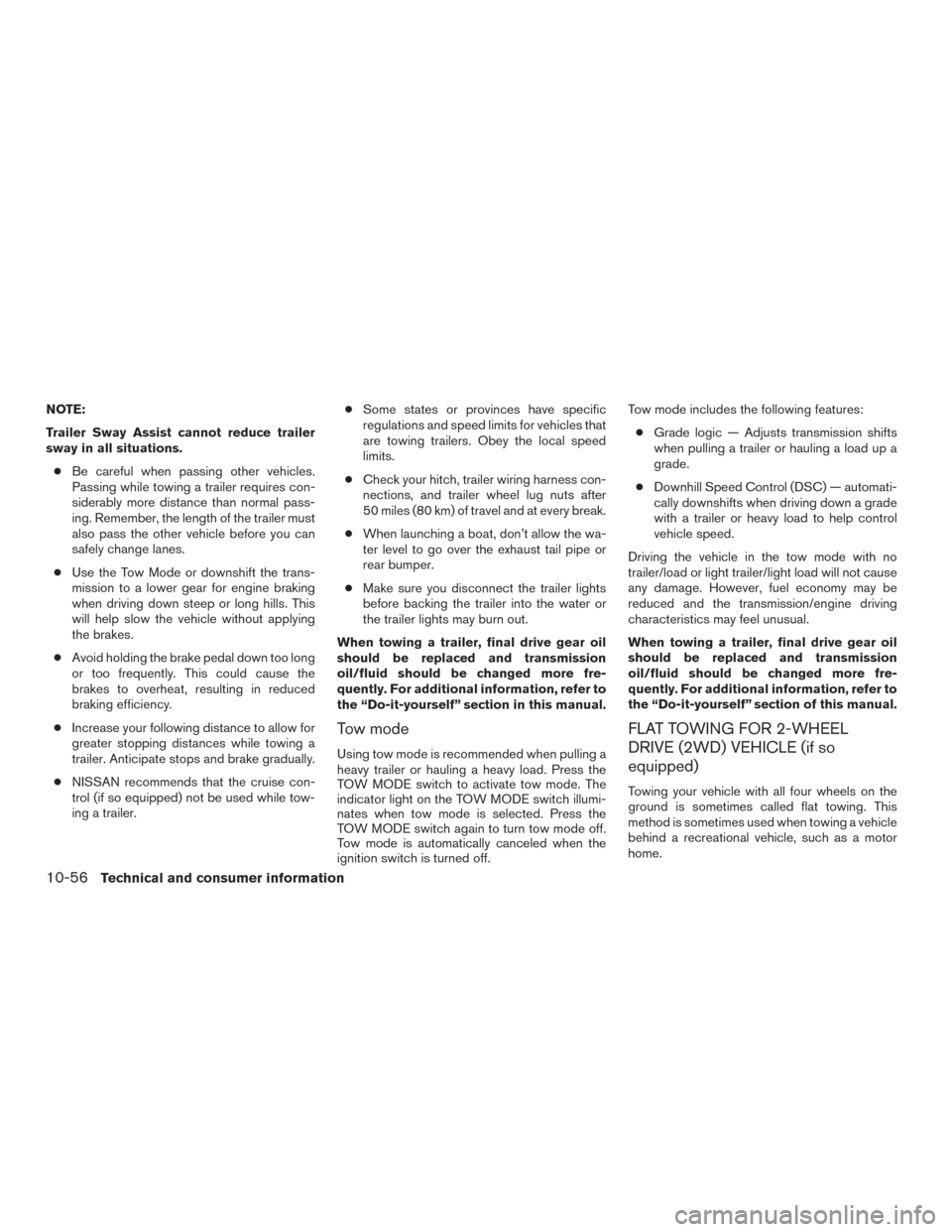
NOTE:
Trailer Sway Assist cannot reduce trailer
sway in all situations.● Be careful when passing other vehicles.
Passing while towing a trailer requires con-
siderably more distance than normal pass-
ing. Remember, the length of the trailer must
also pass the other vehicle before you can
safely change lanes.
● Use the Tow Mode or downshift the trans-
mission to a lower gear for engine braking
when driving down steep or long hills. This
will help slow the vehicle without applying
the brakes.
● Avoid holding the brake pedal down too long
or too frequently. This could cause the
brakes to overheat, resulting in reduced
braking efficiency.
● Increase your following distance to allow for
greater stopping distances while towing a
trailer. Anticipate stops and brake gradually.
● NISSAN recommends that the cruise con-
trol (if so equipped) not be used while tow-
ing a trailer. ●
Some states or provinces have specific
regulations and speed limits for vehicles that
are towing trailers. Obey the local speed
limits.
● Check your hitch, trailer wiring harness con-
nections, and trailer wheel lug nuts after
50 miles (80 km) of travel and at every break.
● When launching a boat, don’t allow the wa-
ter level to go over the exhaust tail pipe or
rear bumper.
● Make sure you disconnect the trailer lights
before backing the trailer into the water or
the trailer lights may burn out.
When towing a trailer, final drive gear oil
should be replaced and transmission
oil/fluid should be changed more fre-
quently. For additional information, refer to
the “Do-it-yourself” section in this manual.
Tow mode
Using tow mode is recommended when pulling a
heavy trailer or hauling a heavy load. Press the
TOW MODE switch to activate tow mode. The
indicator light on the TOW MODE switch illumi-
nates when tow mode is selected. Press the
TOW MODE switch again to turn tow mode off.
Tow mode is automatically canceled when the
ignition switch is turned off. Tow mode includes the following features:
● Grade logic — Adjusts transmission shifts
when pulling a trailer or hauling a load up a
grade.
● Downhill Speed Control (DSC) — automati-
cally downshifts when driving down a grade
with a trailer or heavy load to help control
vehicle speed.
Driving the vehicle in the tow mode with no
trailer/load or light trailer/light load will not cause
any damage. However, fuel economy may be
reduced and the transmission/engine driving
characteristics may feel unusual.
When towing a trailer, final drive gear oil
should be replaced and transmission
oil/fluid should be changed more fre-
quently. For additional information, refer to
the “Do-it-yourself” section of this manual.
FLAT TOWING FOR 2-WHEEL
DRIVE (2WD) VEHICLE (if so
equipped)
Towing your vehicle with all four wheels on the
ground is sometimes called flat towing. This
method is sometimes used when towing a vehicle
behind a recreational vehicle, such as a motor
home.
10-56Technical and consumer information
Page 592 of 671
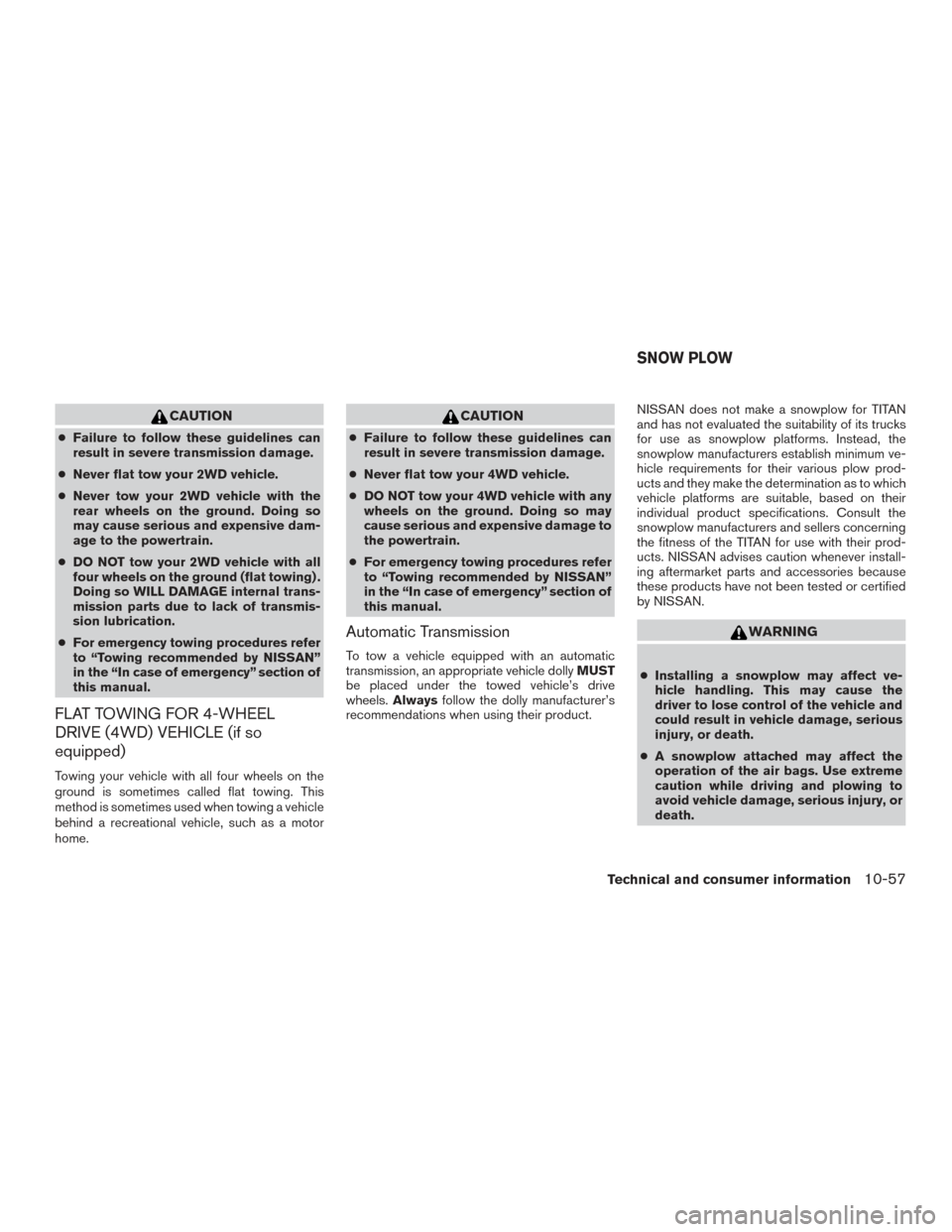
CAUTION
●Failure to follow these guidelines can
result in severe transmission damage.
● Never flat tow your 2WD vehicle.
● Never tow your 2WD vehicle with the
rear wheels on the ground. Doing so
may cause serious and expensive dam-
age to the powertrain.
● DO NOT tow your 2WD vehicle with all
four wheels on the ground (flat towing) .
Doing so WILL DAMAGE internal trans-
mission parts due to lack of transmis-
sion lubrication.
● For emergency towing procedures refer
to “Towing recommended by NISSAN”
in the “In case of emergency” section of
this manual.
FLAT TOWING FOR 4-WHEEL
DRIVE (4WD) VEHICLE (if so
equipped)
Towing your vehicle with all four wheels on the
ground is sometimes called flat towing. This
method is sometimes used when towing a vehicle
behind a recreational vehicle, such as a motor
home.
CAUTION
● Failure to follow these guidelines can
result in severe transmission damage.
● Never flat tow your 4WD vehicle.
● DO NOT tow your 4WD vehicle with any
wheels on the ground. Doing so may
cause serious and expensive damage to
the powertrain.
● For emergency towing procedures refer
to “Towing recommended by NISSAN”
in the “In case of emergency” section of
this manual.
Automatic Transmission
To tow a vehicle equipped with an automatic
transmission, an appropriate vehicle dolly MUST
be placed under the towed vehicle’s drive
wheels. Always follow the dolly manufacturer’s
recommendations when using their product. NISSAN does not make a snowplow for TITAN
and has not evaluated the suitability of its trucks
for use as snowplow platforms. Instead, the
snowplow manufacturers establish minimum ve-
hicle requirements for their various plow prod-
ucts and they make the determination as to which
vehicle platforms are suitable, based on their
individual product specifications. Consult the
snowplow manufacturers and sellers concerning
the fitness of the TITAN for use with their prod-
ucts. NISSAN advises caution whenever install-
ing aftermarket parts and accessories because
these products have not been tested or certified
by NISSAN.
WARNING
●
Installing a snowplow may affect ve-
hicle handling. This may cause the
driver to lose control of the vehicle and
could result in vehicle damage, serious
injury, or death.
● A snowplow attached may affect the
operation of the air bags. Use extreme
caution while driving and plowing to
avoid vehicle damage, serious injury, or
death.
SNOW PLOW
Technical and consumer information10-57
Page 595 of 671
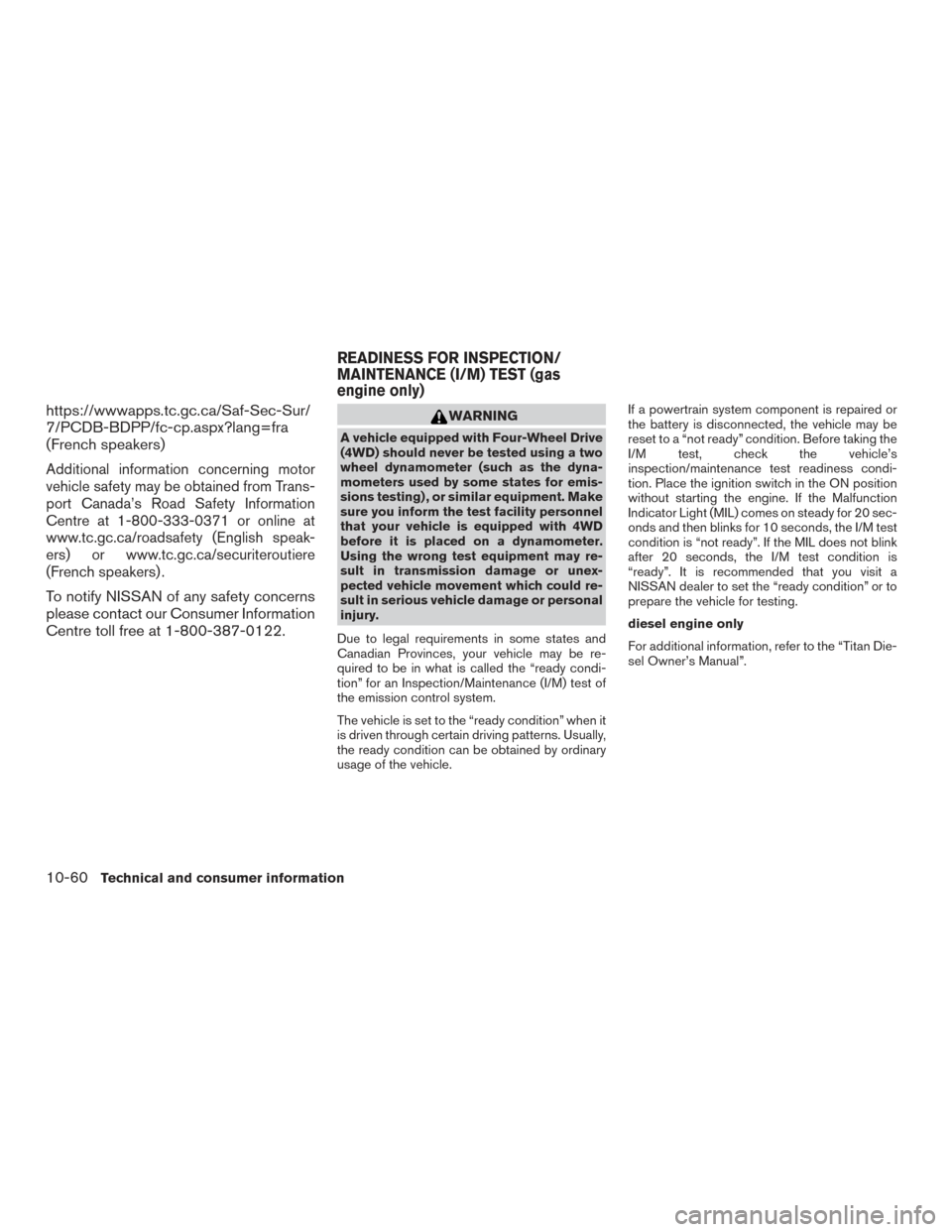
https://wwwapps.tc.gc.ca/Saf-Sec-Sur/
7/PCDB-BDPP/fc-cp.aspx?lang=fra
(French speakers)
Additional information concerning motor
vehicle safety may be obtained from Trans-
port Canada’s Road Safety Information
Centre at 1-800-333-0371 or online at
www.tc.gc.ca/roadsafety (English speak-
ers) or www.tc.gc.ca/securiteroutiere
(French speakers) .
To notify NISSAN of any safety concerns
please contact our Consumer Information
Centre toll free at 1-800-387-0122.
WARNING
A vehicle equipped with Four-Wheel Drive
(4WD) should never be tested using a two
wheel dynamometer (such as the dyna-
mometers used by some states for emis-
sions testing) , or similar equipment. Make
sure you inform the test facility personnel
that your vehicle is equipped with 4WD
before it is placed on a dynamometer.
Using the wrong test equipment may re-
sult in transmission damage or unex-
pected vehicle movement which could re-
sult in serious vehicle damage or personal
injury.
Due to legal requirements in some states and
Canadian Provinces, your vehicle may be re-
quired to be in what is called the “ready condi-
tion” for an Inspection/Maintenance (I/M) test of
the emission control system.
The vehicle is set to the “ready condition” when it
is driven through certain driving patterns. Usually,
the ready condition can be obtained by ordinary
usage of the vehicle. If a powertrain system component is repaired or
the battery is disconnected, the vehicle may be
reset to a “not ready” condition. Before taking the
I/M test, check the vehicle’s
inspection/maintenance test readiness condi-
tion. Place the ignition switch in the ON position
without starting the engine. If the Malfunction
Indicator Light (MIL) comes on steady for 20 sec-
onds and then blinks for 10 seconds, the I/M test
condition is “not ready”. If the MIL does not blink
after 20 seconds, the I/M test condition is
“ready”. It is recommended that you visit a
NISSAN dealer to set the “ready condition” or to
prepare the vehicle for testing.
diesel engine only
For additional information, refer to the “Titan Die-
sel Owner’s Manual”.
READINESS FOR INSPECTION/
MAINTENANCE (I/M) TEST (gas
engine only)
10-60Technical and consumer information
Page 599 of 671

Brake system...................5-54
Break-in schedule ................5-42
Brightness/contrastbutton............4-9
Brightness control Instrument panel ...............2-56
Bulb check/instrument panel ..........2-22
Bulb replacement ................8-29
C
Capacities and recommended
fuel/lubricants ..................10-2
Cargolightswitch................2-58
Cargo (See vehicle loading information) . . .10-20
Car phone or CB radio .............4-113
CD care and cleaning ..............4-81
CD player (See audio system) . .4-56, 4-62, 4-69
Check tire pressure ...............2-42
Child restraints .......1-24,1-24,1-26,1-28
LATCH (Lower Anchors and Tethers for
CHildren) System ..............1-28
Precautions on child
restraints.....1-26,1-33,1-39,1-43,1-48
Top tether strap anchor point locations . .1-31
Child safety rear door lock ............3-7
Chimes, audible reminders ...........2-31
Cleaningexteriorandinterior........7-2,7-4
Climatecontrolseatswitch...........2-58
Clock setting
(models with Navigation System) ........4-7
Clock setting (models without Navigation
System) ..................4-55,4-59
C.M.V.S.S. certification label .........10-16
Cold weather driving ...............5-65
Compact disc (CD) player ....4-56,4-62,4-69Compass
.....................2-18
Connect phone .................4-84
Console light ...................2-88
Control panel buttons ...............4-4
Back button ..................4-7
Brightness/contrast button ..........4-9
Enterbutton..................4-4
With navigation system ............4-4
Controls Audio controls (steering wheel) .......4-82
Heater and air conditioner controls .....4-43
Heater and air conditioner controls
(manual) ...................4-33
Coolant Capacities and recommended
fuel/lubricants ................10-2
Changingenginecoolant...........8-6
Checking engine coolant level ........8-6
Engine coolant temperature gauge .....2-9
Corrosion protection ...............7-7
Cruisecontrol ...........5-40,5-40,5-41
Cupholders...................2-80
Curtainside-impactandrolloverairbag....1-74
D
Daytime Running Light System .....2-56,8-28
Diesel Particulate Filter (DPF) ..........8-11
Digital video disc DVD ..............4-88
Dimensionsandweights............10-11
Dimmer switch for instrument panel ......2-56
Display......................2-32
Display controls (see control panel buttons) . .4-4
Door locks .....................3-5
Door open warning light .............2-25 Doors
........................3-5
Drive belt .....................8-17
Drive positioner, Automatic ........3-37,3-39
Driving Cold weather driving .............5-65
Driving with automatic transmission ....5-17
Precautions when starting and
driving ...................5-2,5-8
Driving the vehicle ................5-16
E
Eco Drive Report .................5-52
Economy-fuel..................5-44
Electronic
locking rear differential (E-Lock)
system ......................5-51
Electronic locking rear differential (E-Lock)
system switch ..................2-65
Emergency engine shutoff .........5-13,6-2
Emission control information label ......10-17
Emission control system warranty .......10-59
Engine Before starting the engine ..........5-14
Blockheater.................5-66
Capacities and recommended
fuel/lubricants ................10-2
Changing engine coolant ...........8-6
Changingengineoil..............8-8
Changing engine oil filter ...........8-9
Checking engine coolant level ........8-6
Checking engine oil level ...........8-7
Engine compartment check locations ....8-3
Engine coolant temperature gauge .....2-9
Engine cooling system ............8-5
Engineoil ...................8-7
11-2
Page 603 of 671
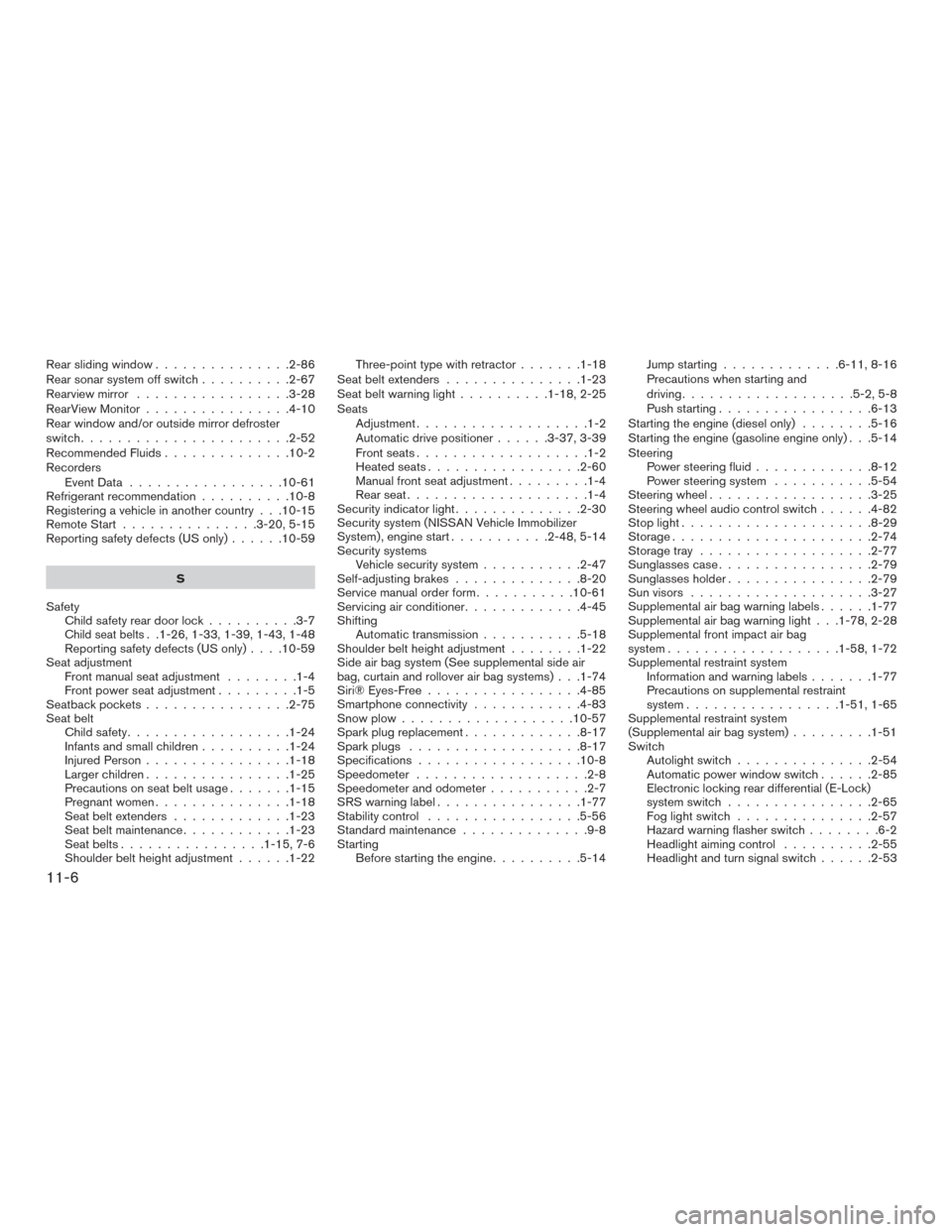
Rear sliding window...............2-86
Rear sonar system off switch ..........2-67
Rearview mirror .................3-28
RearViewMonitor................4-10
Rear window and/or outside mirror defroster
switch .......................2-52
Recommended Fluids ..............10-2
Recorders EventData .................10-61
Refrigerant recommendation ..........10-8
Registering a vehicle in another country . . .10-15
Remote Start ...............3-20,5-15
Reporting safety defects (US only) ......10-59
S
Safety Child safety rear door lock ..........3-7
Child seat belts. .1-26, 1-33, 1-39, 1-43, 1-48
Reporting safety defects (US only) ....10-59
Seat adjustment Front manual seat adjustment ........1-4
Front power seat adjustment .........1-5
Seatback pockets ................2-75
Seat belt Childsafety..................1-24
Infantsandsmallchildren..........1-24
Injured Person ................1-18
Largerchildren................1-25
Precautionsonseatbeltusage.......1-15
Pregnant women ...............1-18
Seat belt extenders .............1-23
Seat belt maintenance ............1-23
Seat belts ................1-15,7-6
Shoulder belt height adjustment ......1-22Three-point type with retractor
.......1-18
Seatbeltextenders ...............1-23
Seat belt warning light ..........1-18,2-25
Seats Adjustment...................1-2
Automatic drive positioner ......3-37,3-39
Frontseats...................1-2
Heatedseats.................2-60
Manual front seat adjustment .........1-4
Rearseat....................1-4
Security indicator light ..............2-30
Security system (NISSAN Vehicle Immobilizer
System) , engine start ...........2-48,5-14
Security systems Vehicle security system ...........2-47
Self-adjusting brakes ..............8-20
Service manual order form ...........10-61
Servicing air conditioner .............4-45
Shifting Automatic transmission ...........5-18
Shoulder belt height adjustment ........1-22
Side air bag system (See supplemental side air
bag, curtain and rollover air bag systems) . . .1-74
Siri® Eyes-Free .................4-85
Smartphone connectivity ............4-83
Snow plow ...................10-57
Sparkplugreplacement.............8-17
Sparkplugs ...................8-17
Specifications ..................10-8
Speedometer ...................2-8
Speedometer and odometer ...........2-7
SRSwarninglabel................1-77
Stability control .................5-56
Standard maintenance ..............9-8
Starting Before starting the engine ..........5-14 Jump starting
.............6-11,8-16
Precautions when starting and
driving ...................5-2,5-8
Push starting .................6-13
Starting the engine (diesel only) ........5-16
Starting the engine (gasoline engine only) . . .5-14
Steering Power steering fluid .............8-12
Power steering system ...........5-54
Steering wheel ..................3-25
Steering wheel audio control switch ......4-82
Stoplight.....................8-29
Storage......................2-74
Storage tray ...................2-77
Sunglasses case .................2-79
Sunglasses holder ................2-79
Sun visors ....................3-27
Supplemental air bag warning labels ......1-77
Supplemental air bag warning light . . .1-78, 2-28
Supplemental front impact air bag
system ...................1-58,1-72
Supplemental restraint system Information and warning labels .......
1-77
Precautions on supplemental restraint
system .................1-51,1-65
Supplemental restraint system
(Supplemental air bag system) .........1-51
Switch Autolightswitch...............2-54
Automatic power window switch ......2-85
Electronic locking rear differential (E-Lock)
system switch ................2-65
Fog light switch ...............2-57
Hazard warning flasher switch ........6-2
Headlightaimingcontrol ..........2-55
Headlightandturnsignalswitch......2-53
11-6
Page 614 of 671
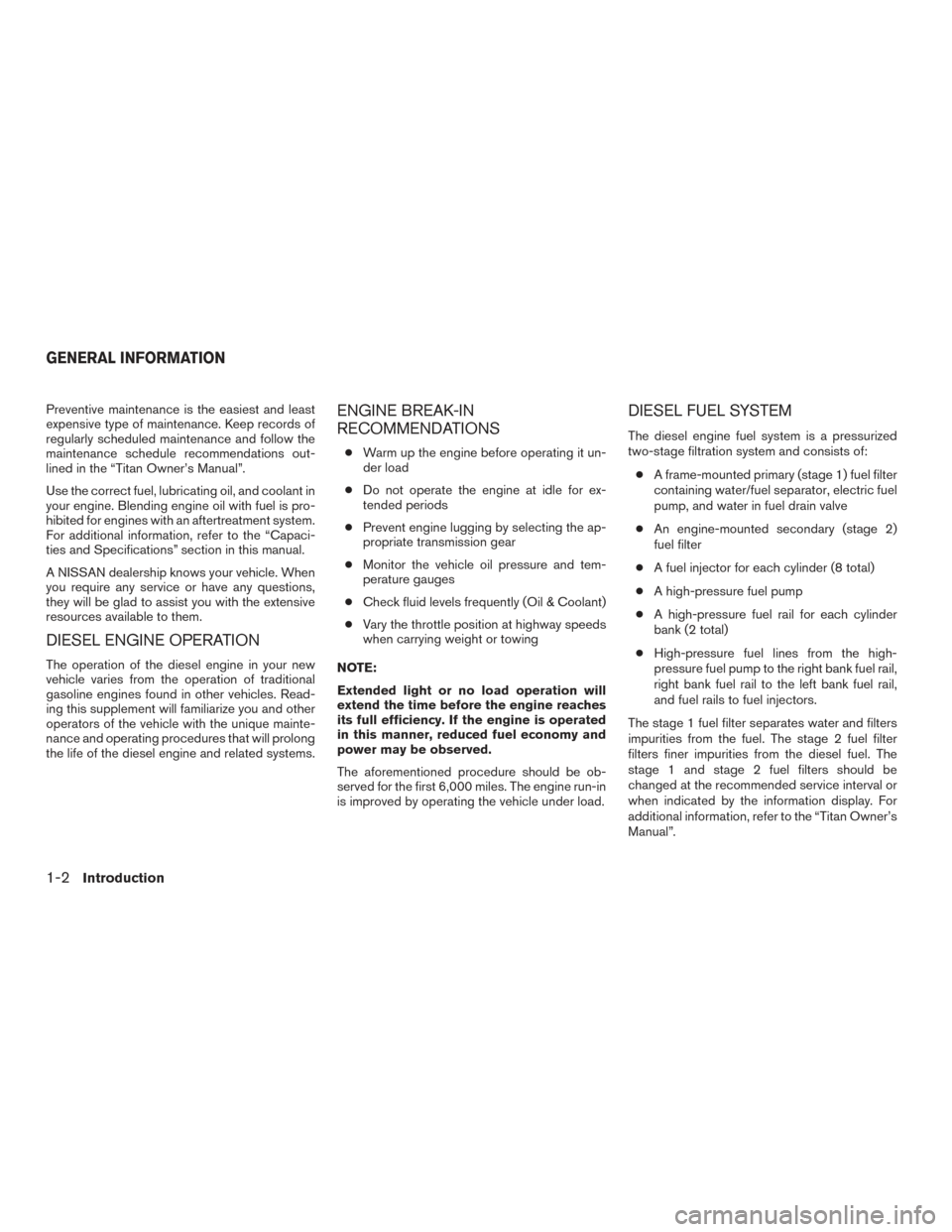
Preventive maintenance is the easiest and least
expensive type of maintenance. Keep records of
regularly scheduled maintenance and follow the
maintenance schedule recommendations out-
lined in the “Titan Owner’s Manual”.
Use the correct fuel, lubricating oil, and coolant in
your engine. Blending engine oil with fuel is pro-
hibited for engines with an aftertreatment system.
For additional information, refer to the “Capaci-
ties and Specifications” section in this manual.
A NISSAN dealership knows your vehicle. When
you require any service or have any questions,
they will be glad to assist you with the extensive
resources available to them.
DIESEL ENGINE OPERATION
The operation of the diesel engine in your new
vehicle varies from the operation of traditional
gasoline engines found in other vehicles. Read-
ing this supplement will familiarize you and other
operators of the vehicle with the unique mainte-
nance and operating procedures that will prolong
the life of the diesel engine and related systems.
ENGINE BREAK-IN
RECOMMENDATIONS
●Warm up the engine before operating it un-
der load
● Do not operate the engine at idle for ex-
tended periods
● Prevent engine lugging by selecting the ap-
propriate transmission gear
● Monitor the vehicle oil pressure and tem-
perature gauges
● Check fluid levels frequently (Oil & Coolant)
● Vary the throttle position at highway speeds
when carrying weight or towing
NOTE:
Extended light or no load operation will
extend the time before the engine reaches
its full efficiency. If the engine is operated
in this manner, reduced fuel economy and
power may be observed.
The aforementioned procedure should be ob-
served for the first 6,000 miles. The engine run-in
is improved by operating the vehicle under load.
DIESEL FUEL SYSTEM
The diesel engine fuel system is a pressurized
two-stage filtration system and consists of: ● A frame-mounted primary (stage 1) fuel filter
containing water/fuel separator, electric fuel
pump, and water in fuel drain valve
● An engine-mounted secondary (stage 2)
fuel filter
● A fuel injector for each cylinder (8 total)
● A high-pressure fuel pump
● A high-pressure fuel rail for each cylinder
bank (2 total)
● High-pressure fuel lines from the high-
pressure fuel pump to the right bank fuel rail,
right bank fuel rail to the left bank fuel rail,
and fuel rails to fuel injectors.
The stage 1 fuel filter separates water and filters
impurities from the fuel. The stage 2 fuel filter
filters finer impurities from the diesel fuel. The
stage 1 and stage 2 fuel filters should be
changed at the recommended service interval or
when indicated by the information display. For
additional information, refer to the “Titan Owner’s
Manual”.
GENERAL INFORMATION
1-2Introduction
Page 627 of 671
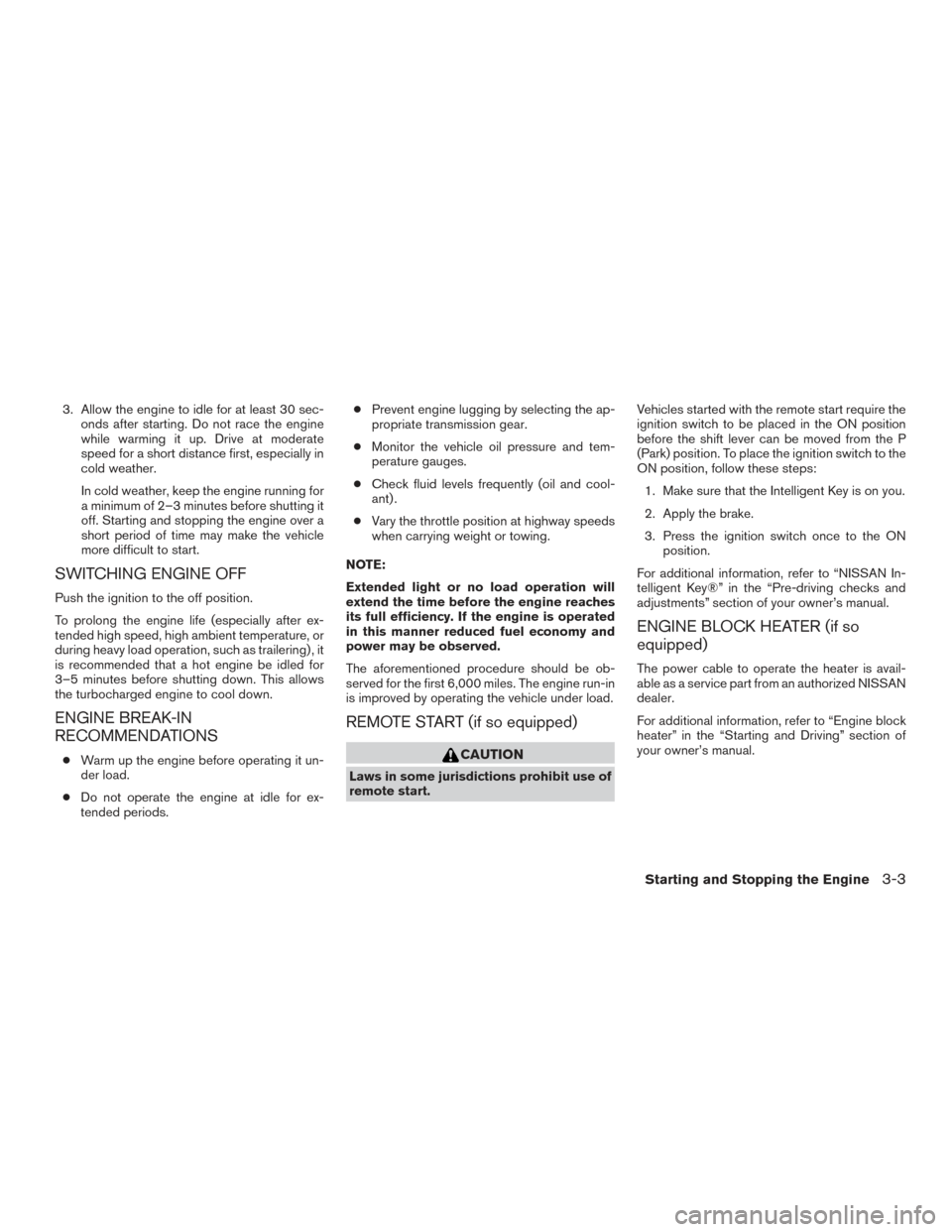
3. Allow the engine to idle for at least 30 sec-onds after starting. Do not race the engine
while warming it up. Drive at moderate
speed for a short distance first, especially in
cold weather.
In cold weather, keep the engine running for
a minimum of 2–3 minutes before shutting it
off. Starting and stopping the engine over a
short period of time may make the vehicle
more difficult to start.
SWITCHING ENGINE OFF
Push the ignition to the off position.
To prolong the engine life (especially after ex-
tended high speed, high ambient temperature, or
during heavy load operation, such as trailering) , it
is recommended that a hot engine be idled for
3–5 minutes before shutting down. This allows
the turbocharged engine to cool down.
ENGINE BREAK-IN
RECOMMENDATIONS
● Warm up the engine before operating it un-
der load.
● Do not operate the engine at idle for ex-
tended periods. ●
Prevent engine lugging by selecting the ap-
propriate transmission gear.
● Monitor the vehicle oil pressure and tem-
perature gauges.
● Check fluid levels frequently (oil and cool-
ant) .
● Vary the throttle position at highway speeds
when carrying weight or towing.
NOTE:
Extended light or no load operation will
extend the time before the engine reaches
its full efficiency. If the engine is operated
in this manner reduced fuel economy and
power may be observed.
The aforementioned procedure should be ob-
served for the first 6,000 miles. The engine run-in
is improved by operating the vehicle under load.
REMOTE START (if so equipped)
CAUTION
Laws in some jurisdictions prohibit use of
remote start. Vehicles started with the remote start require the
ignition switch to be placed in the ON position
before the shift lever can be moved from the P
(Park) position. To place the ignition switch to the
ON position, follow these steps:
1. Make sure that the Intelligent Key is on you.
2. Apply the brake.
3. Press the ignition switch once to the ON position.
For additional information, refer to “NISSAN In-
telligent Key®” in the “Pre-driving checks and
adjustments” section of your owner’s manual.
ENGINE BLOCK HEATER (if so
equipped)
The power cable to operate the heater is avail-
able as a service part from an authorized NISSAN
dealer.
For additional information, refer to “Engine block
heater” in the “Starting and Driving” section of
your owner’s manual.
Starting and Stopping the Engine3-3
Page 639 of 671
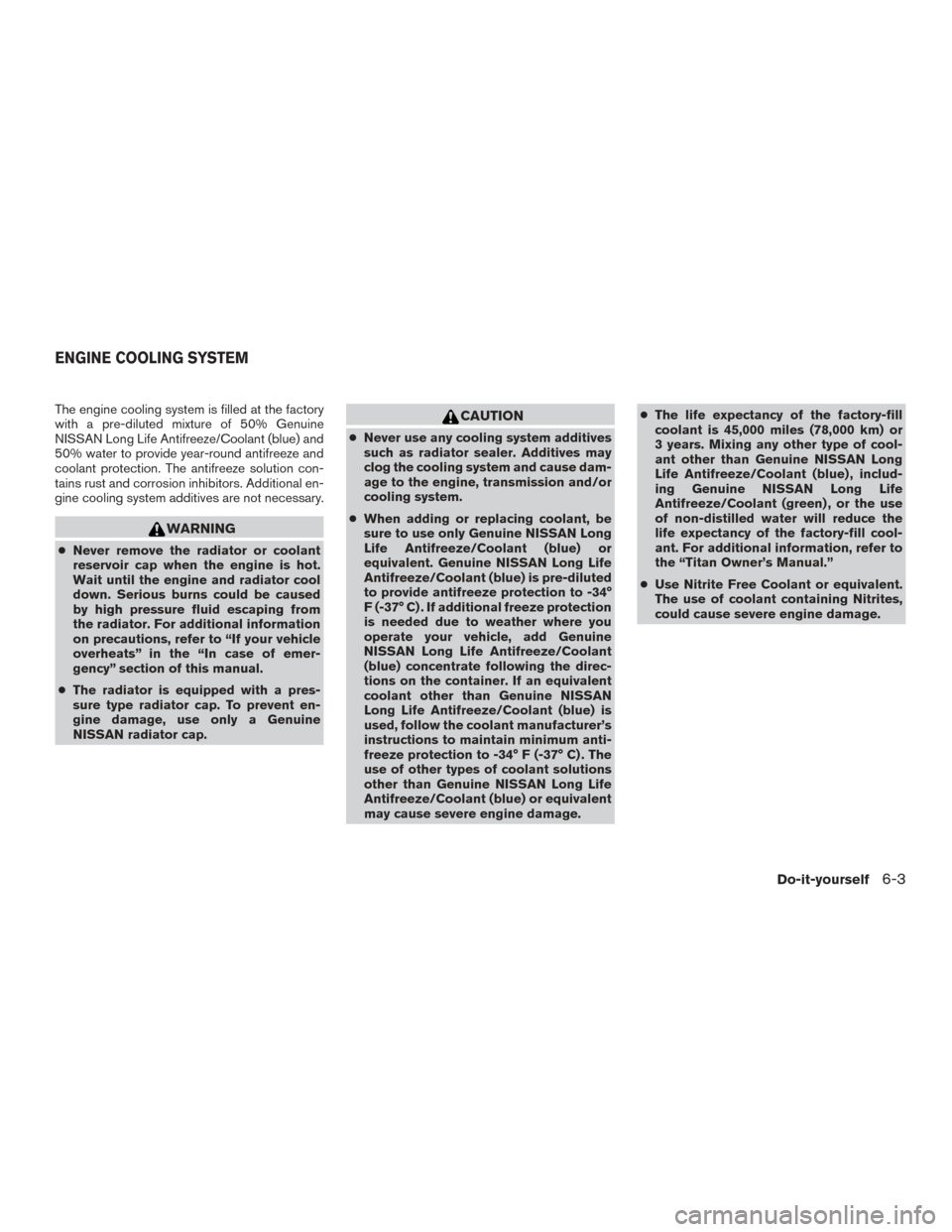
The engine cooling system is filled at the factory
with a pre-diluted mixture of 50% Genuine
NISSAN Long Life Antifreeze/Coolant (blue) and
50% water to provide year-round antifreeze and
coolant protection. The antifreeze solution con-
tains rust and corrosion inhibitors. Additional en-
gine cooling system additives are not necessary.
WARNING
●Never remove the radiator or coolant
reservoir cap when the engine is hot.
Wait until the engine and radiator cool
down. Serious burns could be caused
by high pressure fluid escaping from
the radiator. For additional information
on precautions, refer to “If your vehicle
overheats” in the “In case of emer-
gency” section of this manual.
● The radiator is equipped with a pres-
sure type radiator cap. To prevent en-
gine damage, use only a Genuine
NISSAN radiator cap.
CAUTION
● Never use any cooling system additives
such as radiator sealer. Additives may
clog the cooling system and cause dam-
age to the engine, transmission and/or
cooling system.
● When adding or replacing coolant, be
sure to use only Genuine NISSAN Long
Life Antifreeze/Coolant (blue) or
equivalent. Genuine NISSAN Long Life
Antifreeze/Coolant (blue) is pre-diluted
to provide antifreeze protection to -34°
F (-37° C) . If additional freeze protection
is needed due to weather where you
operate your vehicle, add Genuine
NISSAN Long Life Antifreeze/Coolant
(blue) concentrate following the direc-
tions on the container. If an equivalent
coolant other than Genuine NISSAN
Long Life Antifreeze/Coolant (blue) is
used, follow the coolant manufacturer’s
instructions to maintain minimum anti-
freeze protection to -34° F (-37° C) . The
use of other types of coolant solutions
other than Genuine NISSAN Long Life
Antifreeze/Coolant (blue) or equivalent
may cause severe engine damage. ●
The life expectancy of the factory-fill
coolant is 45,000 miles (78,000 km) or
3 years. Mixing any other type of cool-
ant other than Genuine NISSAN Long
Life Antifreeze/Coolant (blue) , includ-
ing Genuine NISSAN Long Life
Antifreeze/Coolant (green) , or the use
of non-distilled water will reduce the
life expectancy of the factory-fill cool-
ant. For additional information, refer to
the “Titan Owner’s Manual.”
● Use Nitrite Free Coolant or equivalent.
The use of coolant containing Nitrites,
could cause severe engine damage.
ENGINE COOLING SYSTEM
Do-it-yourself6-3